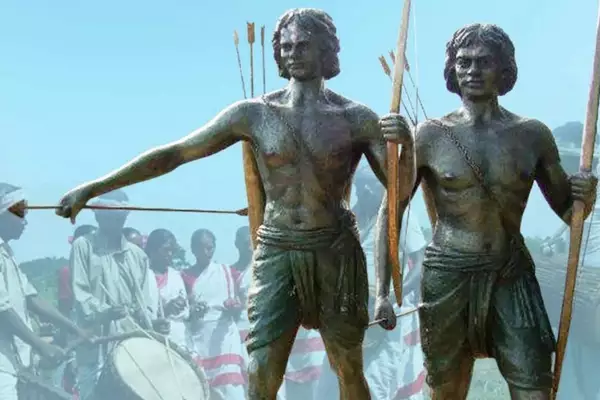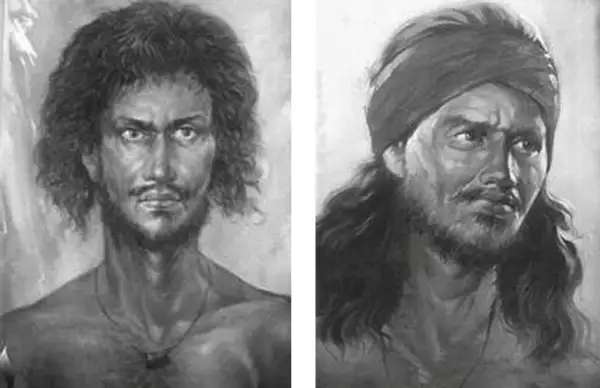Siddhu & Kanhu Murmu were recently remembered for the Death anniversary as their supreme sacrifice during the Santhal Rebellion (1855-56).
About Siddhu & Kanhu Murmu:
- Sido Murmu and Kanhu Murmu were the principal leaders of the Santhal Rebellion, which took place from 1855 to 1856.
- They were brothers and were joined by other key figures, including Chand and Bairab.
Role in Santhal Rebellion:
- In 1832, the British administration demarcated the Damin-i-Koh region in present-day Jharkhand and invited Santhals to settle there with promises of land and economic benefits.
- Many Santhals relocated from regions like Cuttack, Dhalbhum, Manbhum, Hazaribagh, and Midnapore.
- The arrival of British-appointed mahajans and zamindars, who acted as tax collectors, led to widespread exploitation.
- Corrupt money lending practices subjected Santhals to exorbitant interest rates, as they were unable to repay their debts, they lost their lands and were forced into bonded labor.
- On 30 June 1855, Sido and Kanhu mobilized around 10,000 Santhals and declared a rebellion against oppressive zamindari system imposed during Lord Cornwallis’ period.
- The Santhals initially achieved victories and managed to drive British forces out of their territories.
- The British, equipped with modern firearms and war elephants, employed a deceptive tactic during a crucial battle.
- The British troops initially fired blank shots but later fired real bullets, leading to a decisive defeat for the Santhals.
- Phulo and Jhano Murmu, along with Sumi Murmu (wife of Siddhu Murmu), rallied about 20,000 Santhals against the British and sustained the rebellion after the men.
- Following the rebellion, the British enacted Santhal Parganas Tenancy Act (1876) to protect Santhal land rights by making land transfers to non-Santhals illegal.
About Santhals:
- The Santhals are a tribal community primarily found in the Chhotanagpur Plateau region, which spans across parts of Jharkhand, Odisha, West Bengal, and Bihar.
- Santha means calm, and ala means man in the Santhali language.
- They are the third largest scheduled tribe community in India after Gonds and Bhils.
- Santhals are deeply connected to their roots and are nature worshippers, often paying obeisance at Jaher (sacred groves) in their villages.
- Traditional dress for Santhal men includes dhoti and gamuchha, while women typically wear a short-check saree, usually in blue and green, often accompanied by tattoos.
- Various forms of marriage are accepted in Santhal society, including elopement, widow remarriage, levirate, forced marriages (rare), and marriages due to pregnancy.
- Most Santhals are agriculturists, relying on their farmlands and forests, while their homes, called Olah, have a distinctive three-color pattern on the outer walls.
- River Damodar holds a special place in Santhal religious life, as the ashes and bones of the deceased are immersed in it for a peaceful afterlife.
- The Santhali language (written in the Ol Chiki script), belongs to the Munda group and is recognized as a scheduled language in the Eighth Schedule to the Indian Constitution.
- Pre-independence, they were subjected to extortion by the British East India Company and the zamindari system, alongside intermediaries such as moneylenders and upper ryots.
- The Santhals, along with other tribal communities, were granted Scheduled Tribe status through The Constitution (Scheduled Tribes) Order, 1950.
- Tribal communities, outside the Northeast, generally have lower levels of literacy but the Santhals have higher due to pro-school education awareness since the 1960s.
- As a result, these tribals hold significant positions in fields of education, policy making, commerce, signified by Draupadi Murmu as the first tribal President of India.
Ref: Source
| UPSC IAS Preparation Resources | |
| Current Affairs Analysis | Topperspedia |
| GS Shots | Simply Explained |
| Daily Flash Cards | Daily Quiz |
Frequently Asked Question:
Who were Sidhu and Kanhu Murmu?
Sidhu and Kanhu Murmu were brothers and principal leaders of the Santhal Rebellion, which occurred from 1855 to 1856.
What was the Santhal Rebellion?
The Santhal Rebellion was an uprising led by the Santhal community against British colonial authorities and their oppressive systems, including the zamindari system and exploitative money lending practices.
What does the term ‘Santhal’ mean?
The term ‘Santhal’ is derived from the Santhali language, where ‘Santha’ means calm and ‘ala’ means man. The name reflects their identity and cultural heritage.



